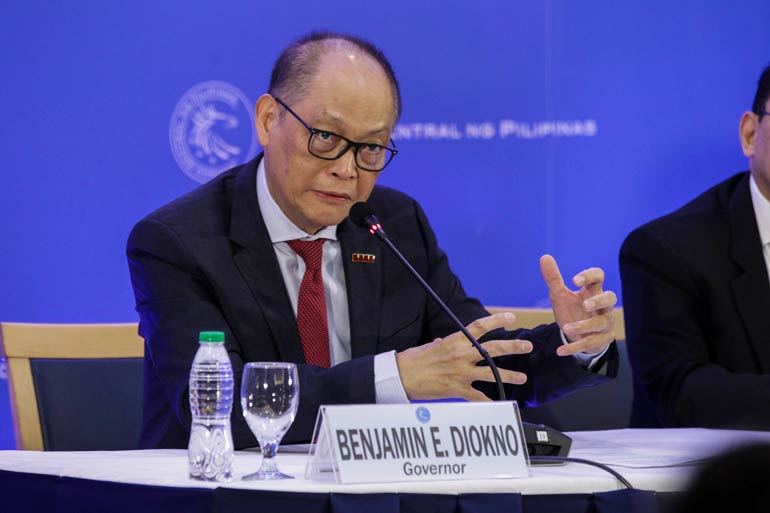By Business World, September 13 2019; Business World
https://www.bworldonline.com/bsp-likely-to-cut-policy-rates-this-month/
Image Credit to Philippine Star
TARLAC — The central bank will cut benchmark interest rates as early as this month, with the regulator also studying when to implement further reductions to lenders’ reserve ratios.
BSP Governor Benjamin E. Diokno told reporters on the sidelines of an event here that the central bank’s planned cuts to interest rates “won’t reach November.”
“Could be October or September,” Mr. Diokno said.
The BSP chief added that they are still studying whether they will announce and implement the planned cuts to policy rates and big banks’ reserve requirement ratio (RRR) in one go or in different events.
The central bank’s Monetary Board holds policy-setting meetings every six weeks. Its remaining reviews for the year are scheduled on Sept. 26, Nov. 14 and Dec. 12.
The BSP has cut rates by a total of 50 basis points (bp) this year — by 25 bps each last May 9 and Aug. 8 — to 4.25% for the overnight reverse repurchase rate, 4.75% for overnight lending and 3.75% for overnight deposit, partially dialing back the 175-bp cumulative hikes triggered last year by successive multi-year high inflation that peaked at a nine-year high.
Mr. Diokno earlier said the central bank is looking to cut policy rates by another 25 bps as well as slash big banks’ RRR before the year ends.
He said the Monetary Board plans to “pre-announce” RRR moves on a quarterly basis to prepare the markets.
Currently, the RRR is at 16% for big banks and six percent for thrift banks following the phased 200-bp cut implemented after an off-cycle meeting last May. The reserve ratio of rural and cooperative lenders was also cut to four percent from five percent effective May 31.
Mr. Diokno has said he is committed to trim universal and commercial banks’ RRR to single digit before his term ends in 2023.
In an email on Friday, ING Bank N.V.-Manila Branch senior economist Nicholas T. Mapa said Mr. Diokno “has all but sealed the deal for a policy rate cut at the Monetary Board’s next meeting.”
“With growth of above 6% for 2019 fading away fast, the decisive move to cut borrowing costs to address now anemic capital formation would be a step in the right direction as the price objective is well in hand,” Mr. Mapa said.
“Meanwhile, we now bring forward our expectation for a pre-announced reduction in RRR to the 26th of September with Diokno charting out a series of 50 bps cuts to RRR, one at the end of October and another at the end of November. Diokno was quoted as saying he would like to announce RRR cuts “quarterly” and we foresee his next announcement to come at the end of this month,” he added.
On the other hand, in a report on Friday, The Hongkong and Shanghai Banking Corp. Ltd. (HSBC) Economist Noelan Arbis said the impact of the BSP’s previous RRR cuts on money supply has been “rather muted.”
“We believe there may be several reasons for this, including a wider trade deficit, greater government bond issuance, policy rate hikes in 2018, and the BSP’s liquidity absorption facilities. These drags on liquidity imply that continued RRR cuts will remain necessary to provide sufficient money supply for growth,” Mr. Arbis said.
Mr. Arbis said HSBC expects big banks’ RRR to fall to 11% by 2021, with the bank also forecasting that the BSP will cut its policy rate by at least another 25 bps and the RRR by another 100 bps by yearend.
“Moreover, we expect further policy rate and RRR cuts in 2020, providing a greater boost to money supply and bank lending domestically,” he said.
“That said, we expect subsequent RRR cuts to eventually translate into higher money supply growth and, by nature, higher bank lending growth… Inflationary risks would require the BSP to play a more active role in liquidity management as it cuts the RRR further. Preventing runaway prices would entail higher TDF (term deposit facility) offerings and greater BSP bill issuance at the first signs of demand-side driven inflation in order to mop up excess liquidity in the financial system,” Mr. Arbis added. — with a report from LWTN

